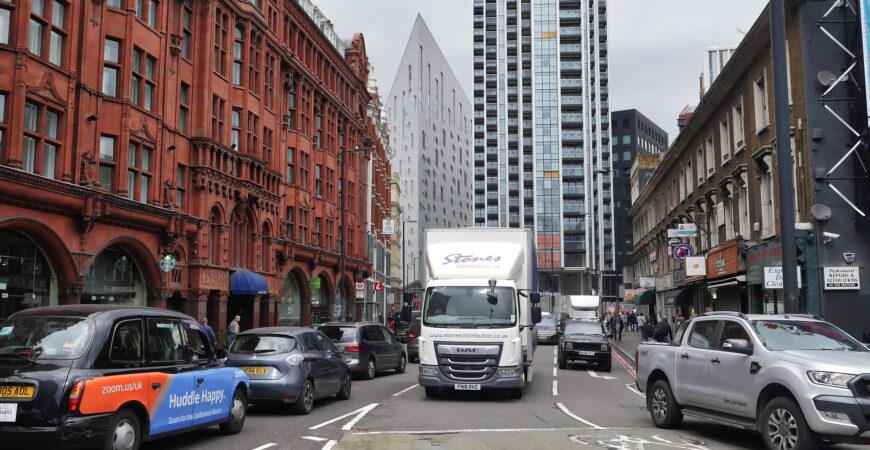What is DVS?
The Direct Vision Standard (DVS) is part of The Mayor of London and TfL’s Vision Zero reform to improve the risk to vulnerable road users such as people walking and cycling, near the vehicle. DVS requires operators of lorries over 12 tonnes gross vehicle weight to apply and obtain a permit to enter or operate in Greater London.
However, as we have previously mentioned here hauliers and fleet managers have been fined more than 7,000 times for failing to comply with DVS regulations. Ensuring DVS requirements are met will provide your drivers with higher levels of visibility protecting them whilst increasing safety for both pedestrians and other road users. Reducing both costly insurance claims and lawsuits along with reducing injuries and deaths caused by commercial vehicles on Britain’s roads.
What does DVS compliant mean?
Between 2011 to 2016, 23% of all cyclist deaths across the UK were due to collisions with HGVs, whilst only 5% of traffic on Britain’s roads were commercial vehicles such as HGVs. In an effort to reduce the number of deaths caused by HGVs and commercial vehicles, the government introduced the Driving Vision Standard or DVS on 26th October 2020 with enforcement beginning on 1st March 2021 to give businesses more time to meet DVS requirements with all the disruption caused by COVID.
The Direct Vision Standard measures how much an HGV driver can see directly through their cab windows and mirrors and if they have any blind spots obstructing their vision. This indicates the level of risk to vulnerable road users, such as people walking and cycling, near the vehicle. Drivers that operate zero-star HGV will have poor direct vision and will not be able to see the head and shoulders of a pedestrian who is less than 4.5m away from the vehicle side. By adding safety equipment, you will achieve your DVS star rating, eliminating the vehicle blind spots.

By adding safety equipment, you will achieve your DVS star rating, eliminating the vehicle blind spots.
What is the legal requirement for DVS compliance?
Currently, to meet the DVS requirements your vehicle must have:
- Class V and VI mirrors or cameras that eliminate blind spots around a vehicle
- A camera monitoring system including side cameras and an in-cab monitor that increase driver visibility
- Near-side proximity sensors with a driver alert that warn drivers of any vulnerable road users on their near-side
- A left-turn audible alarm that warns vulnerable road users when a vehicle indicates left
- Sideguards to reduce the chance of injury to cyclists and pedestrians
- Warning signage to warn road users of the hazards around the vehicle
Find out the DVS rating of your heavy goods vehicle (HGV) over 12 tonnes and apply for a permit if necessary.
We can help you achieve your 3+ star rating and more by installing the following:
- Side cameras and Monitors to cover blind spots
- Left turn warning alarms
- Motion sensors
- Additional front and rear cameras
- AI driver-facing technology
- Reversing camera
- Reversing alert
Do I need a DVS permit?
If you currently own or more HGV (heavy duty vehicles) over 12 tonnes, you will require a safety permit in order to operate within the Greater London area.
If you want to find out how to acquire an HGV permit, please click here

Additional changes in 2024
From 2024, all vehicles over 12 tonnes travelling into Greater London will be required to achieve a minimum 3-star rating, an increase from the 1-star rating currently required. This means that fleets will need to provide better visibility and safety to all their vehicles that travel into Greater London.
What are the penalties?
As mentioned above, hauliers and fleet managers have been fined more than 7,000 times for failing to comply with DVS regulations. With the individual fine set at £550 per fine, not complying is not only bad practice but extremely expensive. Safety in London for both pedestrians and other road users has been heavily emphasised, which makes it likely that other major cities will soon follow suit. Other industry hot topics include: reducing CO2 emissions, the extension of ULEZ and switching to electric vehicles. Much like eco-awareness, road safety is becoming an increasingly dominant issue, and it’s likely the Direct Vision Standard could extend out of London and beyond.
If you need to satisfy the Direct Vision Standard ‘Safe System’ we can provide industry-leading safety technology. Providing the solutions to ensure not just DVS compliance, but also that your business meets the standards required across a range of other safety schemes.
For full details on how to comply with the current DVS requirements please view our previous news item How to Comply with the Direct Vision Standard (DVS).


